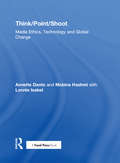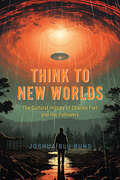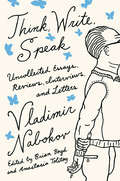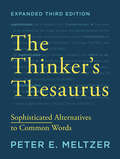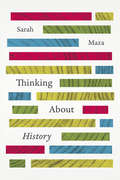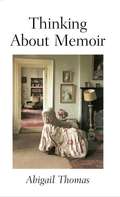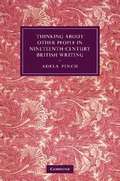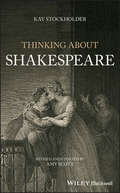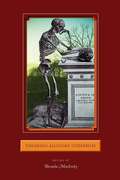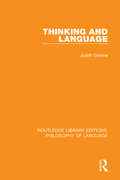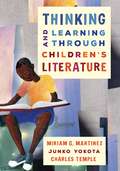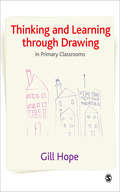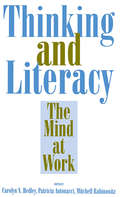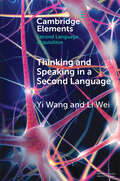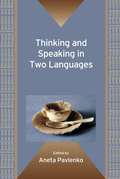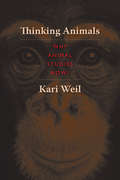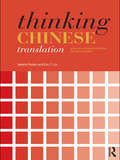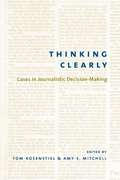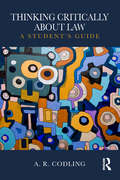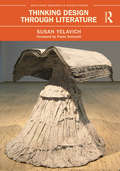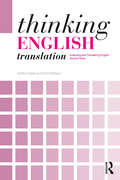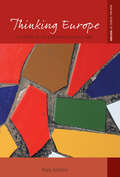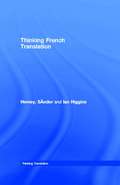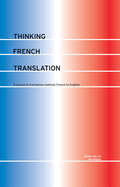- Table View
- List View
Think/Point/Shoot: Media Ethics, Technology and Global Change
by Annette Danto Mobina Hashmi Lonnie IsabelThink/Point/Shoot gives students a thorough overview of the role of ethics in modern media creation. Case studies emphasize the critical issues in global media ethics today in all stages of media creation from preproduction research and development, to production and post production. This volume features practicing filmmakers, journalists, and media creators who provide insight into dealing with real-world ethical dilemmas. For this era, digital imagery, sounds, and web communication have opened doors to sharing thoughts and ideas instantaneously to potentially vast audiences. This presents exciting opportunities, but also serious ethical, legal, and social challenges. The cases and exercises found in this book are applicable to the current media field while still remaining grounded in strong ethical theory. Think/Point/Shoot explains the challenge of communicating a story to a worldwide audience while maintaining ethical standards. A companion website provides additional resources for students and instructors: media ethics game chapter summaries and case studies important forms Instructors will also find: classroom exercises PowerPoints video from the "Global Media Ethics" Conference from March 2013
Think to New Worlds: The Cultural History of Charles Fort and His Followers
by Joshua Blu BuhsHow a writer who investigated scientific anomalies inspired a factious movement and made a lasting impact on American culture. Flying saucers. Bigfoot. Frogs raining from the sky. Such phenomena fascinated Charles Fort, the maverick writer who scanned newspapers, journals, and magazines for reports of bizarre occurrences: dogs that talked, vampires, strange visions in the sky, and paranormal activity. His books of anomalies advanced a philosophy that saw science as a small part of a larger system in which truth and falsehood continually transformed into one another. His work found a ragged following of skeptics who questioned not only science but the press, medicine, and politics. Though their worldviews varied, they shared compelling questions about genius, reality, and authority. At the center of this community was adman, writer, and enfant terrible Tiffany Thayer, who founded the Fortean Society and ran it for almost three decades, collecting and reporting on every manner of oddity and conspiracy. In Think to New Worlds, Joshua Blu Buhs argues that the Fortean effect on modern culture is deeper than you think. Fort’s descendants provided tools to expand the imagination, explore the social order, and demonstrate how power is exercised. Science fiction writers put these ideas to work as they sought to uncover the hidden structures undergirding reality. Avant-garde modernists—including the authors William Gaddis, Henry Miller, and Ezra Pound, as well as Surrealist visual artists—were inspired by Fort’s writing about metaphysical and historical forces. And in the years following World War II, flying saucer enthusiasts convinced of alien life raised questions about who controlled the universe. Buhs’s meticulous and entertaining book takes a respectful look at a cast of oddballs and eccentrics, plucking them from history’s margins and spotlighting their mark on American modernism. Think to New Worlds is a timely consideration of a group united not only by conspiracies and mistrust of science but by their place in an ever-expanding universe rich with unexplained occurrences and visionary possibilities.
Think, Write, Speak: Uncollected Essays, Reviews, Interviews, and Letters to the Editor
by Vladimir NabokovA rich compilation of the previously uncollected Russian and English prose and interviews of one of the twentieth century's greatest writers, edited by Nabokov experts Brian Boyd and Anastasia Tolstoy"I think like a genius, I write like a distinguished author, and I speak like a child": so Nabokov famously, and infamously, wrote when introducing his 1973 volume of selected prose, Strong Opinions. Think, Write, Speak follows up where Strong Opinions left off, presenting Nabokov's public writings from a 1921 essay about Cambridge to two last interviews in 1977. The chronological order allows us to watch the Cambridge student and the fledgling Berlin reviewer and poet turn into the acclaimed Paris émigré novelist whose stature would bring him to teach and write in America, where his international success exploded with Lolita and propelled him back to Europe as a recognized literary master. Straddling Russian, French and Anglophone worlds, Nabokov discovers contemporary literature and culture at his own pace and with his own strong dispositions. Whether his subject is Proust or Pushkin, the sport of boxing or the privileges of democracy, Nabokov's supreme individuality and his alertness to the details of life past and present illuminate the page and remind us why he has been called the greatest of prose stylists.
The Thinker's Thesaurus: Sophisticated Alternatives to Common Words (Expanded Third Edition)
by Peter E. MeltzerWith over twenty percent more material, a must for any lover of distinctive words. This entertaining and informative reference features sophisticated and surprising alternatives to common words together with no-fail guides to usage. Avoiding traditional thesauruses' mundane synonym choices, Peter E. Meltzer puts each word--whether it's protrepic, apostrophize, iracund, or emulous--in context by using examples from a broad range of contemporary books, periodicals, and newspapers. His new introduction makes the case for why we should widen our vocabulary and use the one right word. This groundbreaking thesaurus remains a unique venture, one that enriches your writing while helping you find the perfect word.
Thinking about Content Reading
by Kylene BeersThis book is designed to help you read your social studies books. It contains activities that will help you learn how to focus on important information and discover meaning as you read. This book has the following three parts: * Reading Skills * Think-Alouds * Graphic Organizers Each part focuses on specific skills or strategies you can use to improve your reading.
Thinking About History
by Sarah MazaWhat distinguishes history as a discipline from other fields of study? That's the animating question of Sarah Maza’s Thinking About History, a general introduction to the field of history that revels in its eclecticism and highlights the inherent tensions and controversies that shape it. Designed for the classroom, Thinking About History is organized around big questions: Whose history do we write, and how does that affect what stories get told and how they are told? How did we come to view the nation as the inevitable context for history, and what happens when we move outside those boundaries? What is the relation among popular, academic, and public history, and how should we evaluate sources? What is the difference between description and interpretation, and how do we balance them? Maza provides choice examples in place of definitive answers, and the result is a book that will spark classroom discussion and offer students a view of history as a vibrant, ever-changing field of inquiry that is thoroughly relevant to our daily lives.
Thinking About Memoir
by Abigail ThomasIf living is an art, it must be practiced with diligence before being done with ease. Yet almost nothing in our culture prepares us for reflection on the great themes of existence: courage, friendship, listening, dignity--those everyday virtues that can transform our world. Because AARP believes it's never too late (or too early) to learn, they, together with Sterling Publishing, have created theAbout Livingseries to address these crucial issues. Each entry will be written by only the best authors and thinkers. Thinking About Memoir, the first of these volumes, helps adults look back at their past and use writing as a means of figuring out who they used to be and how they became who they are today. It's written by Abigail Thomas, whose own memoirA Three Dog Lifewas selected as one of the Best Books of 2006 by the LA Times and the Washington Post and called "perfectly honed" (Newsweek), "bracingly honest" (Vanity Fair), and "stunning" by theLos Angeles Book Review. Thomas writes that memoir can consist of looking back at a single summer or the span of a whole life. Through her experience as a writing teacher, she knows how difficult that can be; this book is about the habit of writing as a way to keep track of what's going on in the front and the back of your mind. It inspires different ways for us to look at the moment we're in right now and will help would-be memoirists find their own "side door" into a subject. Thomas writes eloquently about how to get started and find that jumping-off point for your work, and provides exercises that liberate our creativity, enable us to get the distance and perspective we need, and open our eyes to possibilities that may not at first seem obvious. Whether your words are for publication, for your loved ones, or for you alone, Thomas makes the process fulfilling, thoughtful, and even fun.
Thinking about Other People in Nineteenth-Century British Writing
by Adela PinchNineteenth-century life and literature are full of strange accounts that describe the act of one person thinking about another as an ethically problematic, sometimes even a dangerously powerful thing to do. Adela Pinch explains why, when, and under what conditions it is possible, or desirable, to believe that thinking about another person could affect them. She explains why nineteenth century British writers - poets, novelists, philosophers, psychologists, devotees of the occult - were both attracted to and repulsed by radical or substantial notions of purely mental relations between persons, and why they moralized about the practice of thinking about other people in interesting ways. Working at the intersection of literary studies and philosophy, this book both sheds new light on a neglected aspect of Victorian literature and thought, and explores the consequences of, and the value placed on, this strand of thinking about thinking.
Thinking About Shakespeare
by StockholderExplores the challenges of maintaining bonds, living up to ideals, and fulfilling desire in Shakespeare’s plays In Thinking About Shakespeare, Kay Stockholder reveals the rich inner lives of some of Shakespeare’s most enigmatic characters and the ways in which their emotions and actions shape and are shaped by the social and political world around them. In addressing all genres in the Shakespeare canon, the authors explore the possibility of people being constant to each other in many different kinds of relationships: those of lovers, kings and subjects, friends, and business partners. While some bonds are irrevocably broken, many are reaffirmed. In all cases, the authors offer insight into what drives Shakespeare’s characters to do what they do, what draws them together or pulls them apart, and the extent to which bonds can ever be eternal. Ultimately, the most durable bond may be between the playwright and the audience, whereby the playwright pleases and the audience approves. The book takes an in-depth look at a dozen of The Bard’s best-loved works, including: A Midsummer Night’s Dream; Romeo and Juliet; The Merchant of Venice; Richard II; Henry IV, Part I; Hamlet; Troilus and Cressida; Othello; Macbeth; King Lear; Antony and Cleopatra; and The Tempest. It also provides an epilogue titled: Prospero and Shakespeare. Written in a style accessible for all levels Discusses 12 plays, making it a comprehensive study of Shakespeare’s work Covers every genre of The Bard’s work, giving readers a full sense of Shakespeare’s art/thought over the course of his oeuvre Provides a solid overall sense of each play and the major characters/plot lines in them Providing new and sometimes unconventional and provocative ways to think about characters that have had a long critical heritage, Thinking About Shakespeare is an enlightening read that is perfect for scholars, and ideal for any level of student studying one of history’s greatest storytellers.
Thinking Allegory Otherwise
by Brenda MachoskyThinking Allegory Otherwise is a unique collection of essays by allegory specialists and other scholars who engage allegory in exciting new ways. The contributors include Jody Enders, Karen Feldman, Angus Fletcher, Blair Hoxby, Brenda Machosky, Catherine Gimelli Martin, Stephen Orgel, Maureen Quilligan, James Paxson, Daniel Selcer, Gordon Teskey, and Richard Wittman. The essays are not limited to an examination of literary texts and works of art, and in fact focus on a wide range of topics that includes architecture, philosophy, theatre, science, and law. The book proves the truth of the statement that all language is allegorical, and more importantly it shows its consequences. To "think allegory otherwise" is to think otherwise-- to rethink not only the idea of allegory itself, but also the law and its execution, the literality of figurative abstraction, and the figurations upon which even hard science depends.
Thinking and Language: Topics In Cognitive Psychology (New Essential Psychology Ser.)
by Judith GreeneOriginally published in 1875, this book discusses thinking and language and traces the development of different pscyological approaches, assessing their theoretical significance and the experimental evidence behind them. It ends by drawing together the various lines of argument to arrive at some general conclusions about language and thought, since it clearly emerges that the two are inextricably linked.
Thinking And Learning Through Children's Literature
by Miriam G. Martinez Charles Temple Junko YokotaMuch of teachers' attention these days is focused on having students read closely to ferret out the author's intended meaning and the devices used to convey that meaning. But we cannot forget to guide students to have moving engagements with literature, because they need to make strong personal connections to books of merit if they are to become the next generation of readers: literate people with awareness of and concern for the diversity of human beings around them and in different times and places. Fortunately, guiding both students' personal engagement with literature and their close reading to appreciate the author's message and craft are not incompatible goals. <P><P>This book enthusiastically and intelligently addresses both imperatives, first surveying what is gained when students are immersed in literature; then celebrating and explicating the main features of literature students need to understand to broaden their tastes and deepen their engagement, at the same time they meet external standards; then presenting a host of active methods for exploring all major genres of children's books; and finally presenting suggestions for interdisciplinary teaching units grounded in literature. Created by noted leaders in the fields of children's literature and literacy, the book is enlivened by recurring features such as suggested reading lists, issues for discussion, links to technology, and annotations of exemplary books.
Thinking and Learning Through Drawing: In Primary Classrooms
by Mrs Gill Hope'The text is clear and accessible and gives a fascinating overview of how drawing can help children to learn and understand the thinking of others...It is highly recommended for all students and practitioners interested in understanding more about how children express their ideas and theories about the world' - Early Years Update 'This book is an invaluable resource for anyone who recognises the potential of 'drawing' as an essential element for developing thinking and learning in the Primary Classroom...and a 'must read' for those who are sceptical!....This is a fascinating read that invokes a variety of feelings including a sense of wonder and curiosity about the many facets of drawing, which leaves you with a thirst to try out more and explore ways of releasing the untapped potential of 'drawing' in your own classroom' - thinkingclassroom.co.uk Children use drawing as a means through which they create, develop, communicate and record their thoughts and ideas. Whether it's to play, or to express feelings and meaning, drawing enables them to learn about the world, explore their imaginations, and to invent and present new ideas. With an extensive background in teaching and researching children's uses of drawing, Gill Hope describes the ways in which multiple forms of drawing are used by Primary school children. She explains why it should be actively promoted as a means of supporting thinking and learning across a wide range of subject areas, and provides practical support for teachers. Demonstrating the importance of drawing, and combining a thematic approach with practical guidance, this informative and enjoyable book: - widens teachers' understanding of the multiple uses of drawing; - shows how children can be guided to use it to support thinking and learning; - explores the range of applications in which drawing can be used across all areas of the curriculum; - looks to the future and at the ever increasing importance of graphic literacy. Providing a fresh insight into the uses of drawing as a powerful tool which supports children's thinking and learning, this book will be of interest to everyone involved in the development of children's capabilities, including teachers, student teachers and teaching assistants.
Thinking and Literacy: The Mind at Work
by N. Hedley Carolyn Antonacci Patricia Rabinowitz MitchellThis volume explores higher level, critical, and creative thinking, as well as reflective decision making and problem solving -- what teachers should emphasize when teaching literacy across the curriculum. Focusing on how to encourage learners to become independent thinking, learning, and communicating participants in home, school, and community environments, this book is concerned with integrated learning in a curriculum of inclusion. It emphasizes how to provide a curriculum for students where they are socially interactive, personally reflective, and academically informed. Contributors are authorities on such topics as cognition and learning, classroom climates, knowledge bases of the curriculum, the use of technology, strategic reading and learning, imagery and analogy as a source of creative thinking, the nature of motivation, the affective domain in learning, cognitive apprenticeships, conceptual development across the disciplines, thinking through the use of literature, the impact of the media on thinking, the nature of the new classroom, developing the ability to read words, the bilingual, multicultural learner, crosscultural literacy, and reaching the special learner. The applications of higher level thought to classroom contexts and materials are provided, so that experienced teacher educators, and psychologists are able to implement some of the abstractions that are frequently dealt with in texts on cognition. Theoretical constructs are grounded in educational experience, giving the volume a practical dimension. Finally, appropriate concerns regarding the new media, hypertext, bilingualism, and multiculturalism as they reflect variation in cognitive experience within the contexts of learning are presented.
Thinking and Speaking in a Second Language (Elements in Second Language Acquisition)
by Yi Wang Li WeiDoes the language we speak affect the way we think? This Element provides a synthesis of contemporary research on the interplay between language and cognition in speakers of two or more languages and examines variables deemed to impact bilingual acquisition and conceptualization of language-specific thinking patterns during L2 learning. An overview of different yet interrelated studies is offered across a variety of conceptual domains to illustrate different approaches and key variables. The comparison of monolingual and bilingual data demonstrates the highly integrative nature between L2 learning and the changing of one's entire cognitive outlook in L2 speakers. This Element makes relevant connections between language learning and bilingual cognition, aiming to shed new light on how learners acquire conceptual distinctions of the target language(s). It also raises theoretical and pedagogical issues that encourage teachers to reflect upon how to incorporate recent advances in language-and-cognition research with aspects of L2 teaching.
Thinking and Speaking in Two Languages
by Aneta PavlenkoUntil recently, the history of debates about language and thought has been a history of thinking of language in the singular. The purpose of this volume is to reverse this trend and to begin unlocking the mysteries surrounding thinking and speaking in bi- and multilingual speakers. If languages influence the way we think, what happens to those who speak more than one language? And if they do not, how can we explain the difficulties second language learners experience in mapping new words and structures onto real-world referents? The contributors to this volume put forth a novel approach to second language learning, presenting it as a process that involves conceptual development and restructuring, and not simply the mapping of new forms onto pre-existing meanings.
Thinking Animals: Why Animal Studies Now?
by Kari WeilKari Weil provides a critical introduction to the field of animal studies as well as an appreciation of its thrilling acts of destabilization. Examining real and imagined confrontations between human and nonhuman animals, she charts the presumed lines of difference between human beings and other species and the personal, ethical, and political implications of those boundaries. Weil's considerations recast the work of such authors as Kafka, Mann, Woolf, and Coetzee, and such philosophers as Nietzsche, Heidegger, Derrida, Deleuze, Agamben, Cixous, and Hearne, while incorporating the aesthetic perspectives of such visual artists as Bill Viola, Frank Noelker, and Sam Taylor-Wood and the "visual thinking" of the autistic animal scientist Temple Grandin. She addresses theories of pet keeping and domestication; the importance of animal agency; the intersection of animal studies, disability studies, and ethics; and the role of gender, shame, love, and grief in shaping our attitudes toward animals. Exposing humanism's conception of the human as a biased illusion, and embracing posthumanism's acceptance of human and animal entanglement, Weil unseats the comfortable assumptions of humanist thought and its species-specific distinctions.
Thinking Chinese Translation: Chinese to English
by Valerie Pellatt Eric T. LiuThinking Chinese Translation is a practical and comprehensive course for advanced undergraduates and postgraduate students of Chinese. Thinking Chinese Translation explores the ways in which memory, general knowledge, and creativity (summed up as ‘schema’) contribute to the linguistic ability necessary to create a good translation. The course develops the reader’s ability to think deeply about the texts and to produce natural and accurate translations from Chinese into English. A wealth of relevant illustrative material is presented, taking the reader through a number of different genres and text types of increasing complexity including: technical, scientific and legal texts journalistic and informative texts literary and dramatic texts. Each chapter provides a discussion of the issues of a particular text type based on up-to-date scholarship, followed by practical translation exercises. The chapters can be read independently as research material, or in combination with the exercises. The issues discussed range from the fine detail of the text, such as punctuation, to the broader context of editing, packaging and publishing translations. Major aspects of teaching and learning translation, such as collaboration, are also covered. Thinking Chinese Translation is essential reading for advanced undergraduate and postgraduate students of Chinese and translation studies. The book will also appeal to a wide range of language students and tutors through the general discussion of the principles and purpose of translation.
Thinking Clearly: Cases in Journalistic Decision-Making
by Tom Rosenstiel Amy MitchellWritten by leading professional journalists and classroom-tested at schools of journalism, Thinking Clearly is designed to provoke conversation about the issues that shape the production and presentation of the news in the twenty-first century. These case studies depict real-life moments when people working in the news had to make critical decisions. Bearing on questions of craft, ethics, competition, and commerce, they cover a range of topics—the commercial imperatives of newsroom culture, standards of verification, the competition of public and private interests, including the question of privacy—in a variety of key episodes: Watergate, the Richard Jewell case, John McCain's 2000 presidential campaign, and the Columbine shooting, among others.
Thinking Critically About Law: A Student's Guide
by A. R. CodlingSo you’ve arrived at university, you’ve read the course handbook and you’re ready to learn the law. But is knowing the law enough to get you the very best marks? And what do your lecturers mean when they say you need to develop critical and analytical skills? When is it right to put your own views forward? What are examiners looking for when they give feedback to say that your work is too descriptive? This book explores what it means to think critically and offers practical tips and advice for students to develop the process, skill and ability of thinking critically while studying law. The book investigates the big questions such as: What is law? and What is ‘thinking critically’? How can I use critical thinking to get better grades in assessments? What is the role of critical thinking in the work place? These questions and more are explored in Thinking Critically About Law. Whether you have limited prior experience of critical thinking or are looking to improve your performance in assessments, this book is the ideal tool to help you enhance your capacity to question, challenge, reflect and problematize what you learn about the law throughout your studies and beyond.
Thinking Design Through Literature (Routledge Research in Design Studies)
by Susan YelavichThis book deploys literature to explore the social lives of objects and places. The first book of its kind, it embraces things as diverse as escalators, coins, skyscrapers, pottery, radios, and robots, and encompasses places as various as home, country, cities, streets, and parks. Here, fiction, poetry, and literary non-fiction are mined for stories of design, which are paired with images of contemporary architecture and design. Through the work of authors such as César Aires, Nicholson Baker, Lydia Davis, Orhan Pamuk, and Virginia Woolf, this book shows the enormous influence that places and things exert in the world.
Thinking English Translation: Analysing and Translating English Source Texts (Thinking Translation)
by Stella Cragie Ann PattisonThinking English Translation is a practical guide to analysing and translating English source texts. Section I focuses on pre-translation analysis where students are guided to consider the features of a variety of English texts and the various implications for translation into other languages. Section II examines language variety in English in more detail and provides strategies for dealing with translation challenges in a wide range of text types. Thinking English Translation gives students a framework for a better understanding of how to approach source texts in order to tackle translation assignments, whether in class or in the workplace, with confidence. Stella Cragie a Qualified Member of the Institute of Translation and Interpreting, and former Principal Lecturer in Translation at the University of Westminster, is now a freelance translator. Ann Pattison is a former Senior Lecturer in Translation at the University of Westminster and now works as a freelance translator, editor and writer.
Thinking Europe: A History of the European Idea since 1800 (Making Sense of History #46)
by Mats AndrénPresenting a new historical narrative on European integration and identity this title examines how the concept of Europe has been entangled in a dynamic and dramatic tension between calls for unity and arguments for borders and division. Through an in-depth intellectual history of the idea of Europe, Mats Andren interrogates the concept of integration and more recent debates surrounding European identity across the nineteenth and early twentieth centuries and the post-war period. Applying a broad range of original sources this unique work will be key reading for students and researchers studying European History, European Studies, Political History and related fields.
Thinking French Translation: A Course In Translation Method-french To English (Thinking Translation)
by Sándor Hervey Ian HigginsThe new edition of this popular course in translation from French into English offers a challenging practical approach to the acquisition of translation skills, with clear explanations of the theoretical issues involved. A variety of translation issues are considered including:*cultural differences*register and dialect*genre*revision and editing.The course now covers texts from a wide range of sources, including:*journalism and literature*commercial, legal and technical texts*songs and recorded interviews.This is essential reading for advanced undergraduates and postgraduate students of French on translation courses. The book will also appeal to wide range of language students and tutors.
Thinking French Translation (Thinking Translation)
by Sándor Hervey Ian HigginsThe new edition of this popular course in translation from French into English offers a challenging practical approach to the acquisition of translation skills, with clear explanations of the theoretical issues involved. A variety of translation issues are considered including:*cultural differences*register and dialect*genre*revision and editing.The course now covers texts from a wide range of sources, including:*journalism and literature*commercial, legal and technical texts*songs and recorded interviews.This is essential reading for advanced undergraduates and postgraduate students of French on translation courses. The book will also appeal to wide range of language students and tutors.A tutors' handbook offering invaluable guidance on how to use the text is available for free download at http://www.routledge.com/cw/thinkingtranslation/
